Abstract
Propionibacterium acnes, the target of inflammation in acne, was tested for its sensitivity to the bactericidal and degradative functions of human polymorphonuclear leukocytes (PMN), monocytes, and their fractions. P. acnes strains were not killed by PMN under any conditions and were variably killed by monocytes in the presence of serum from acne patients. Control strains of Staphylococcus aureus and Micrococcus lysodeicticus were susceptible to both PMN and monocyte killing. P. acnes strains were also not killed by lysozyme, chymotrypsin, H2O2, human serum, PMN granule lysate, and PMN and monocyte cell lysates. The organism was sensitive to the bactericidal activity of myeloperoxidase in acid pH. In addition, P. acnes was shown to be relatively resistant to the degradative action of PMN and monocyte lysates, whereas M. lysodeicticus, S. aureus, and Staphylococcus epidermidis were all degraded to various degrees. The moieties that were liberated from P. acnes by PMN enzymes were predominantly low in molecular weight (1,000 to 25,000) and were consistent with cell wall fragments.
Full text
PDF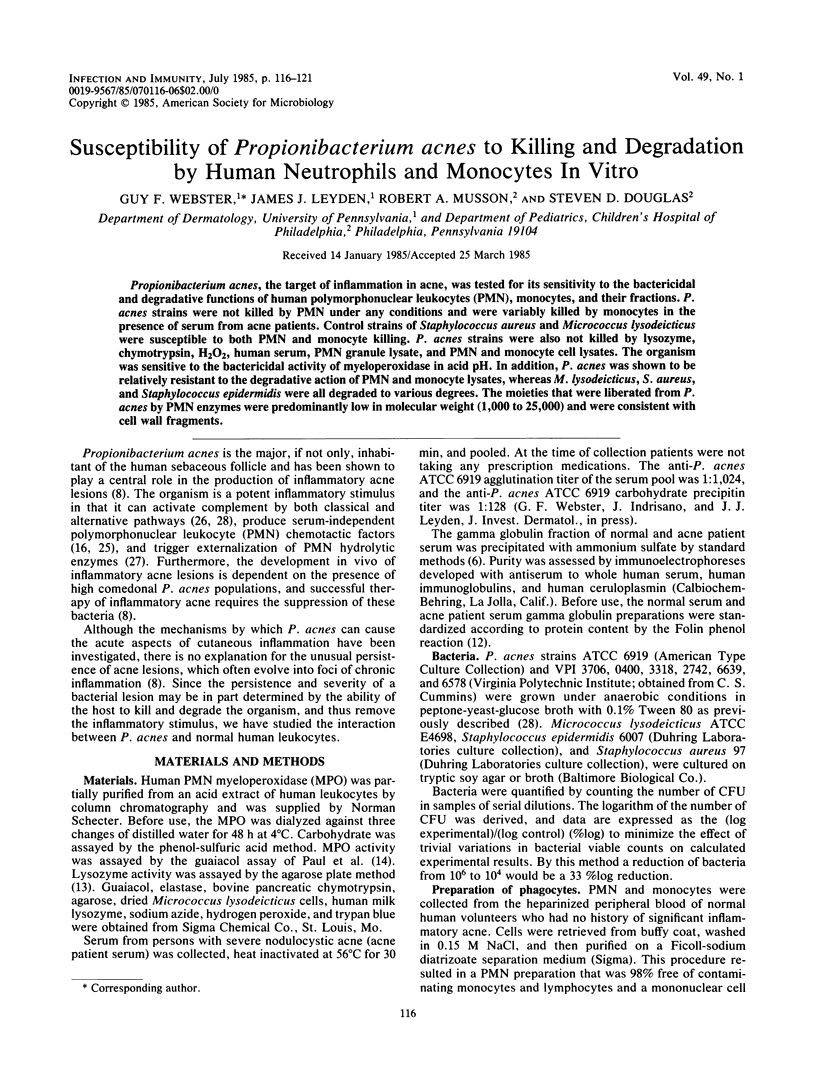
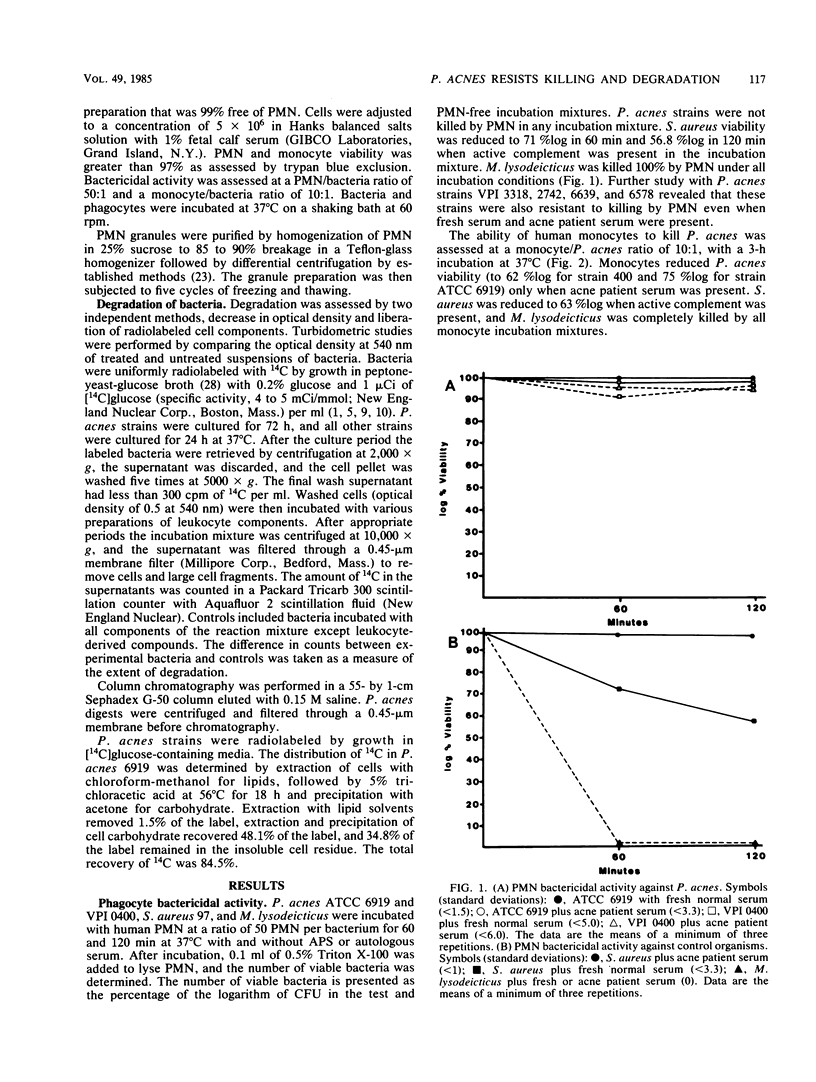
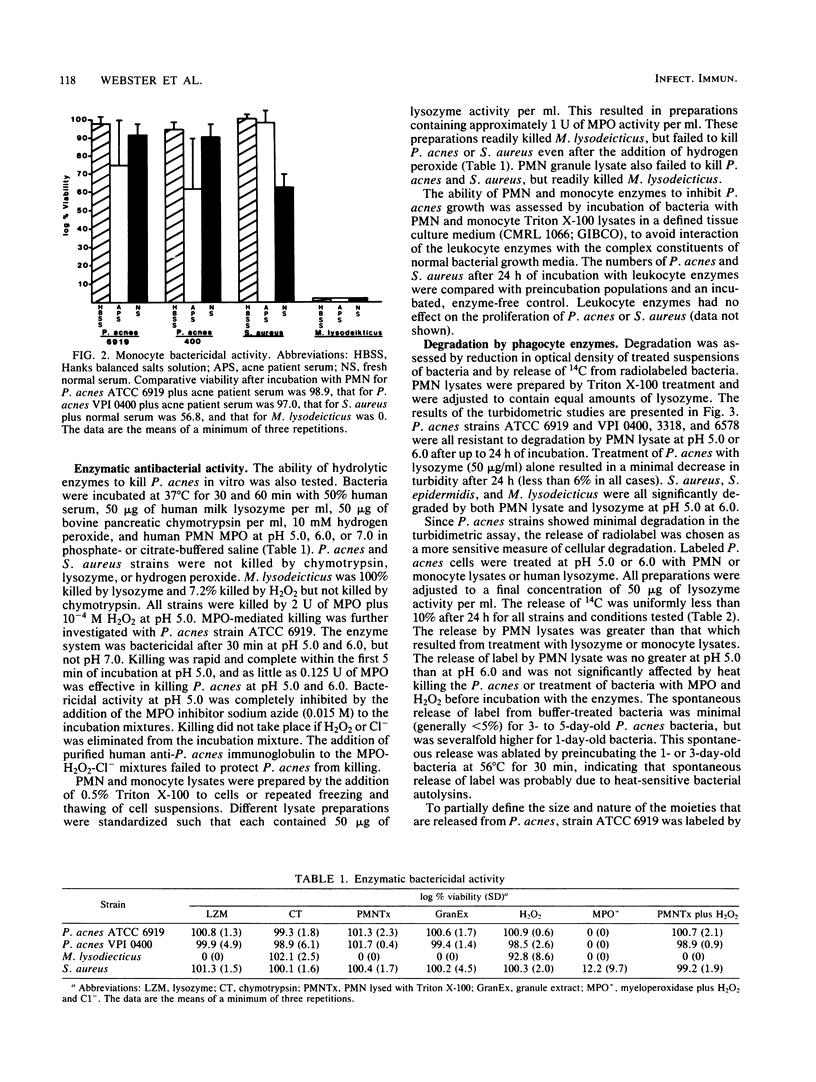
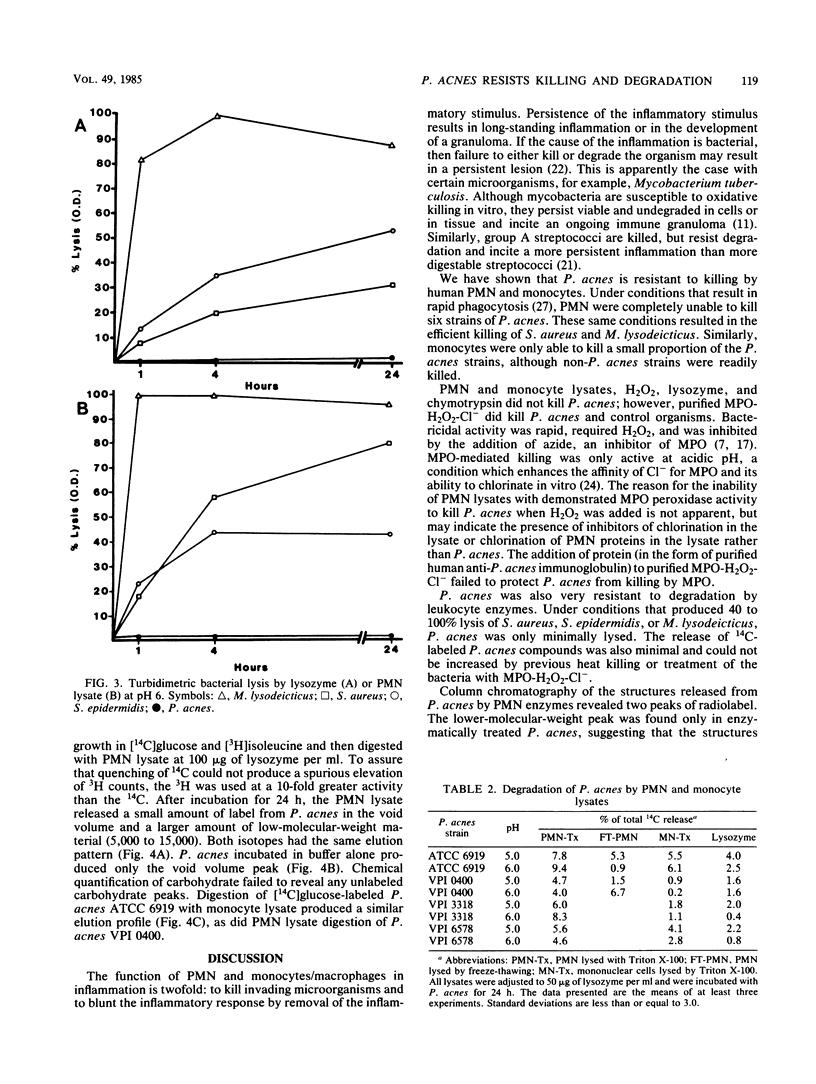
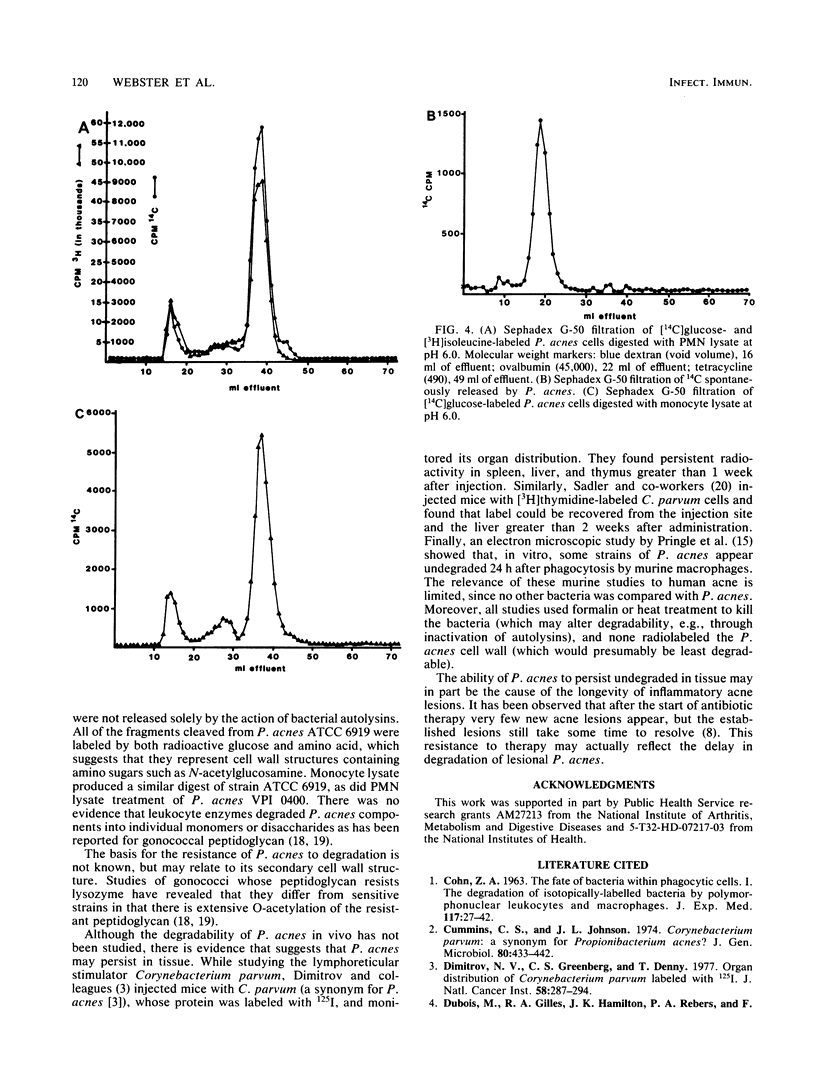
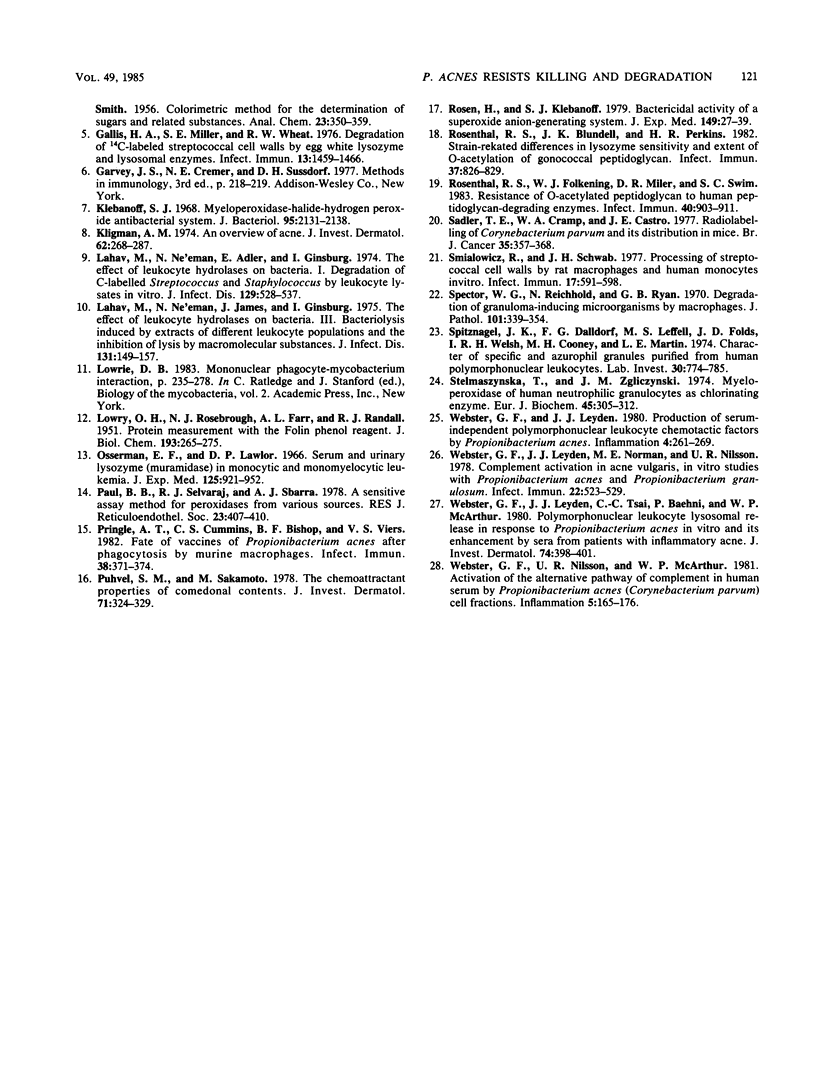
Selected References
These references are in PubMed. This may not be the complete list of references from this article.
- COHN Z. A. The fate of bacteria within phagocytic cells. I. The degradation of isotopically labeled bacteria by polymorphonuclear leucocytes and macrophages. J Exp Med. 1963 Jan 1;117:27–42. doi: 10.1084/jem.117.1.27. [DOI] [PMC free article] [PubMed] [Google Scholar]
- Cummins C. S., Johnson J. L. Corynebacterium parvum: a synonym for Propionibacterium acnes? J Gen Microbiol. 1974 Feb;80(2):433–442. doi: 10.1099/00221287-80-2-433. [DOI] [PubMed] [Google Scholar]
- Dimitrov N. V., Greenberg C. S., Denny T. Organ distribution of Corynebacterium parvum labeled with iodine-125. J Natl Cancer Inst. 1977 Feb;58(2):287–294. doi: 10.1093/jnci/58.2.287. [DOI] [PubMed] [Google Scholar]
- Gallis H. A., Miller S. E., Wheat R. W. Degradation of 14C-labeled streptococcal cell walls by egg white lysozyme and lysosomal enzymes. Infect Immun. 1976 May;13(5):1459–1466. doi: 10.1128/iai.13.5.1459-1466.1976. [DOI] [PMC free article] [PubMed] [Google Scholar]
- Klebanoff S. J. Myeloperoxidase-halide-hydrogen peroxide antibacterial system. J Bacteriol. 1968 Jun;95(6):2131–2138. doi: 10.1128/jb.95.6.2131-2138.1968. [DOI] [PMC free article] [PubMed] [Google Scholar]
- Kligman A. M. An overview of acne. J Invest Dermatol. 1974 Mar;62(3):268–287. doi: 10.1111/1523-1747.ep12676801. [DOI] [PubMed] [Google Scholar]
- LOWRY O. H., ROSEBROUGH N. J., FARR A. L., RANDALL R. J. Protein measurement with the Folin phenol reagent. J Biol Chem. 1951 Nov;193(1):265–275. [PubMed] [Google Scholar]
- Lahav M., Ne'eman N., Adler E., Ginsburg I. Effect of leukocyte hydrolases on bacteria. I. Degradation of 14C-labeled Streptococcus and Staphylococcus by leukocyte lysates in vitro. J Infect Dis. 1974 May;129(5):528–537. doi: 10.1093/infdis/129.5.528. [DOI] [PubMed] [Google Scholar]
- Lahav M., Ne'eman N., James J., Ginsburg I. The effect of leukocyte hydrolases on bacteria. III. Bacteriolysis induced by extracts of different leukocyte populations and the inhibition of lysis by macromolecular substances. J Infect Dis. 1975 Feb;131(2):149–157. doi: 10.1093/infdis/131.2.149. [DOI] [PubMed] [Google Scholar]
- Osserman E. F., Lawlor D. P. Serum and urinary lysozyme (muramidase) in monocytic and monomyelocytic leukemia. J Exp Med. 1966 Nov 1;124(5):921–952. doi: 10.1084/jem.124.5.921. [DOI] [PMC free article] [PubMed] [Google Scholar]
- Paul B. B., Selvaraj R. J., Sbarra A. J. A sensitive assay method for peroxidases from various sources. J Reticuloendothel Soc. 1978 May;23(5):407–410. [PubMed] [Google Scholar]
- Pringle A. T., Cummins C. S., Bishop B. F., Viers V. S. Fate of vaccines of Propionibacterium acnes after phagocytosis by murine macrophages. Infect Immun. 1982 Oct;38(1):371–374. doi: 10.1128/iai.38.1.371-374.1982. [DOI] [PMC free article] [PubMed] [Google Scholar]
- Puhvel S. M., Sakamoto M. The chemoattractant properties of comedonal components. J Invest Dermatol. 1978 Nov;71(5):324–329. doi: 10.1111/1523-1747.ep12529815. [DOI] [PubMed] [Google Scholar]
- Rosen H., Klebanoff S. J. Bactericidal activity of a superoxide anion-generating system. A model for the polymorphonuclear leukocyte. J Exp Med. 1979 Jan 1;149(1):27–39. doi: 10.1084/jem.149.1.27. [DOI] [PMC free article] [PubMed] [Google Scholar]
- Rosenthal R. S., Blundell J. K., Perkins H. R. Strain-related differences in lysozyme sensitivity and extent of O-acetylation of gonococcal peptidoglycan. Infect Immun. 1982 Aug;37(2):826–829. doi: 10.1128/iai.37.2.826-829.1982. [DOI] [PMC free article] [PubMed] [Google Scholar]
- Rosenthal R. S., Folkening W. J., Miller D. R., Swim S. C. Resistance of O-acetylated gonococcal peptidoglycan to human peptidoglycan-degrading enzymes. Infect Immun. 1983 Jun;40(3):903–911. doi: 10.1128/iai.40.3.903-911.1983. [DOI] [PMC free article] [PubMed] [Google Scholar]
- Sadler T. E., Cramp W. A., Castro J. E. Radiolabelling of Corynebacterium parvum and its distribution in mice. Br J Cancer. 1977 Mar;35(3):357–368. doi: 10.1038/bjc.1977.50. [DOI] [PMC free article] [PubMed] [Google Scholar]
- Smialowicz R. J., Schwab J. H. Processing of streptococcal cell walls by rat macrophages and human monocytes in vitro. Infect Immun. 1977 Sep;17(3):591–598. doi: 10.1128/iai.17.3.591-598.1977. [DOI] [PMC free article] [PubMed] [Google Scholar]
- Spector W. G., Reichhold N., Ryan G. B. Degradation of granuloma-inducing micro-organisms by macrophages. J Pathol. 1970 Aug;101(4):339–354. doi: 10.1002/path.1711010407. [DOI] [PubMed] [Google Scholar]
- Spitznagel J. K., Dalldorf F. G., Leffell M. S., Folds J. D., Welsh I. R., Cooney M. H., Martin L. E. Character of azurophil and specific granules purified from human polymorphonuclear leukocytes. Lab Invest. 1974 Jun;30(6):774–785. [PubMed] [Google Scholar]
- Stelmaszyńska T., Zgliczyński J. M. Myeloperoxidase of human neutrophilic granulocytes as chlorinating enzyme. Eur J Biochem. 1974 Jun 1;45(1):305–312. doi: 10.1111/j.1432-1033.1974.tb03555.x. [DOI] [PubMed] [Google Scholar]
- Webster G. F., Leyden J. J. Characterization of serum-independent polymorphonuclear leukocyte chemotactic factors produced by Propionibacterium acnes. Inflammation. 1980 Sep;4(3):261–269. doi: 10.1007/BF00915027. [DOI] [PubMed] [Google Scholar]
- Webster G. F., Leyden J. J., Norman M. E., Nilsson U. R. Complement activation in acne vulgaris: in vitro studies with Propionibacterium acnes and Propionibacterium granulosum. Infect Immun. 1978 Nov;22(2):523–529. doi: 10.1128/iai.22.2.523-529.1978. [DOI] [PMC free article] [PubMed] [Google Scholar]
- Webster G. F., Leyden J. J., Tsai C. C., Baehni P., McArthur W. P. Polymorphonuclear leukocyte lysosomal release in response to Propionibacterium acnes in vitro and its enhancement by sera from inflammatory acne patients. J Invest Dermatol. 1980 Jun;74(6):398–401. doi: 10.1111/1523-1747.ep12544494. [DOI] [PubMed] [Google Scholar]
- Webster G. F., Nilsson U. R., McArthur W. P. Activation of the alternative pathway of complement in human serum by Propionibacterium acnes (Corynebacterium parvum) cell fractions. Inflammation. 1981 Jun;5(2):165–176. doi: 10.1007/BF00914205. [DOI] [PubMed] [Google Scholar]


